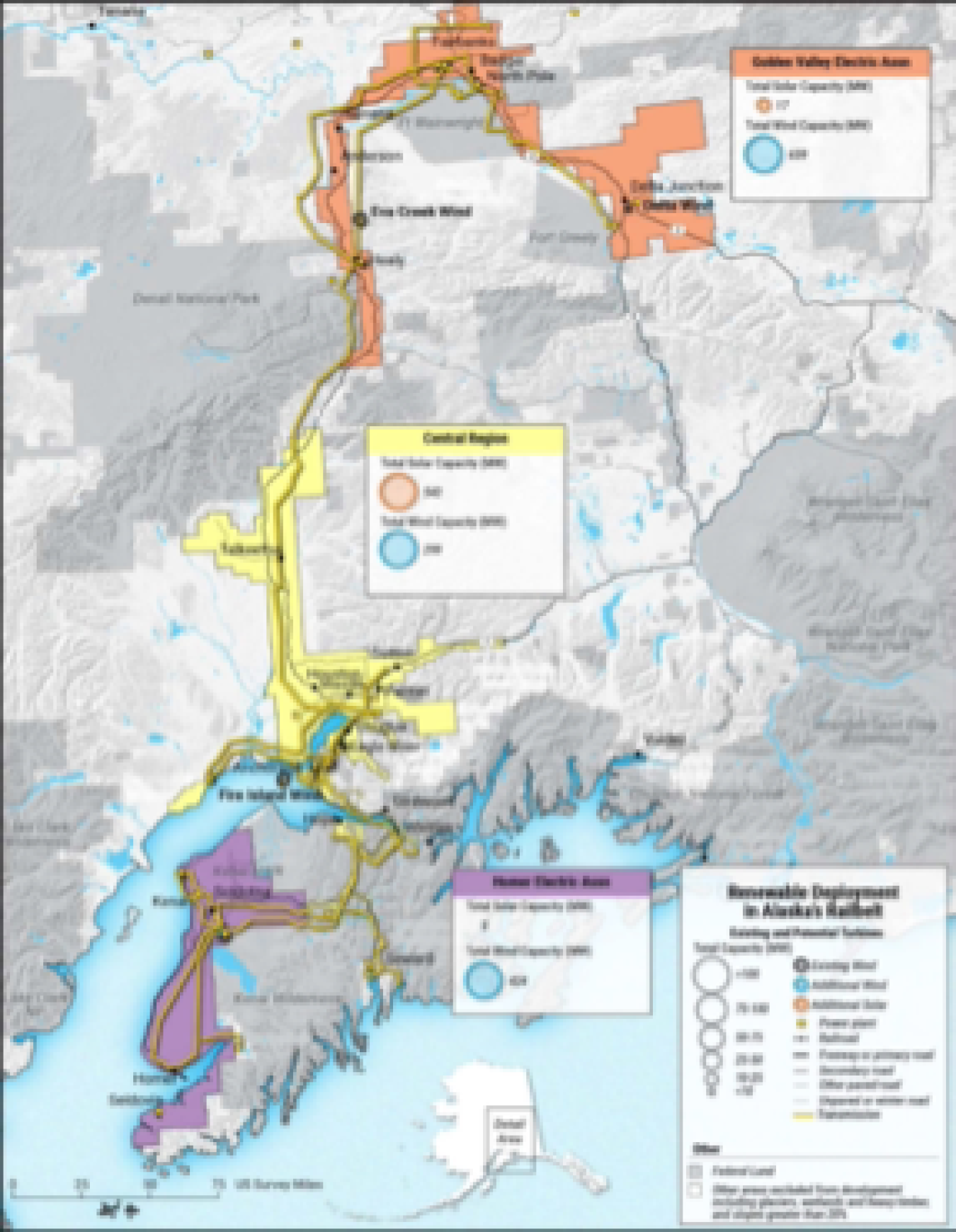Building large-scale renewable energy projects can save Railbelt customers money, compared to a status quo scenario. Read more in our analysis of a report by the National Renewable Energy Laboratory on the Renewable Portfolio Standard (RPS) for Alaska.
March 13, 2024
The National Renewable Energy Laboratory published an 80% Renewable Portfolio Standard (RPS) analysis for Alaska’s “Railbelt,” the term used to refer to Alaska’s largest electrical grid which stretches from Fairbanks in the interior to Homer on the southern tip of the Kenai Peninsula and serves the majority of the state’s population. This report arrives at a time when the Railbelt is facing a natural gas shortage and potential natural gas imports by electric utilities, all against the backdrop of a global energy transition to sustainable energy sources.
This analysis is a follow-up to a 2022 study which showed that renewable energy sources could provide at least 80% of the Railbelt’s energy needs and was used as justification for an RPS that was introduced in the Alaska State Legislature.
The new report takes the next step in showing that building large-scale renewable energy projects can also save Railbelt customers money, compared to a status quo scenario. This is because the costs of building the renewable energy projects are offset by reduced spending on natural gas—the price of which is expected to increase as Alaska likely begins to import it.
These types of studies are based on models that estimate electricity production from different energy sources (natural gas, hydroelectric, coal, wind, solar, tidal, etc.) and then compare that generation to historical records of electricity usage. These historical records are typically adjusted to account for anticipated long-term changes in electricity usage—for example, electrical vehicle charging and other forms of load growth—and they use statistical methods to account for seasonal, daily, and hourly variations in both the resource inputs as well as the electricity usage.
These models are then used to evaluate ‘capacity scenarios,’ where each scenario is a particular mix of electricity generation sources (both renewable and conventional) that provide electricity to the grid at particular locations. If the model identifies time periods when the electricity provided by the energy sources does not meet all of the demand for power on the grid, the scenario is adjusted—by increasing the size of some stations—so that it does.
In the 2022 study, the researchers used these tools to show that there are many different 80% renewable scenarios that provide power to all consumers throughout the entire year. In other words, the study showed that while generation from renewable sources does vary, it is possible to design the Railbelt electricity system in such a way that it keeps the lights on 24-7 and does so using 80% renewable energy.
The latest study takes the next critical step of looking at the costs of these scenarios, and it applies optimization tools to identify the one that is lowest cost. The analysis uses cost information from a database of renewable energy costs based on NREL’s long history of working with the renewable energy sector.
The primary result of this most recent work is that the least-cost scenario includes 75% renewable energy. Forcing the system to 80% renewable energy raises the cost of the system slightly in the year 2040. More importantly—to the level of precision of this kind of analysis—the least-cost scenario and the 80% scenario are effectively the same, which suggests that for the time being an 80% RPS target is a reasonable one to work toward.
Some readers will note that the report does not include nuclear or carbon capture technologies. On this point, the authors are clear that the original scope of this report was focused on assessing the RPS as it was drafted when the work commenced, beginning in 2021. At that time, the idea of building new fossil fuel burning electricity generation that utilizes carbon capture technology was not nearly as widespread as it is today. In the case of nuclear technology, at the present time, it is still much more expensive than renewable and other conventional energy sources.
Whether or not fossil-fuels-with-capture technologies are cheaper than the scenarios that NREL identified is a worthwhile question that deserves more analysis. If carbon capture technologies are sufficiently economical and storage reservoirs secure, they offer critical tools for the energy transition. However, what the NREL’s report tells us now is that installing renewables will save Railbelt customers money compared to a scenario where no new renewables are allowed.
The Railbelt is facing a natural gas shortage, and most utilities are indicating that importing natural gas may be required for an undefined period of time. Whether the Alaska Legislature decides to implement an RPS, or a Clean Energy Standard (CES), or do nothing at all (more on that debate here), NREL’s study shows that a path of creating a modern energy system—one that includes new jobs and uses local renewable energy resources—is more affordable than doing nothing and relying on imported gas.
The good news is that Railbelt utilities have already begun heading in this direction. There is already 263 MW of renewables on the grid, and several utilities have issued request for proposals for new renewable energy projects. Reaching the lowest-cost case would require installing 1679 MW between now and 2040. It’s a big task, but it’s also doable.
Levi Kilcher

Dr. Levi Kilcher is the Former Senior Energy Advisor for the Arctic Energy Office, and departed DOE effective December 31, 2024. In this role he supported the Director of the Arctic Energy Office in implementing DOE’s Arctic Strategy, with special focus on implementing the strategic goal to advance the decarbonization, resilience, and equity of the Arctic energy sector and broader economy.
Prior to joining the Arctic Energy Office, Levi was the lead scientist for marine energy resource characterization at the National Renewable Energy Laboratory (NREL). In this role he helped chart NREL’s marine energy research strategy, authored numerous publications on measuring and quantifying marine energy resources, and—in collaboration with partners Pacific Northwest National Laboratory and Sandia National Labs—published high-resolution marine resource datasets via novel tools such as the marine energy atlas. As a contributing author of marine energy standards for the International Electrotechnical Commission (TC114), he applied marine energy standards in his work and brought his hands-on marine measurement experience to the development of those standards. Throughout his career at NREL he also supported several rural Alaskan communities to identify renewable energy options appropriate to their environment, including but not limited to marine energy.
Levi grew up on Dena’ina Lands near Homer, Alaska. He completed a B.S. in Physics and a PhD in Physical Oceanography, both at Oregon State University. He is passionate about identifying local renewable energy options that meet the cultural, environmental, and economic needs of communities of all scales, and he believes Alaska has a unique and impactful role to play in the energy economy of the future. When not at work he enjoys rock climbing, running, mountain biking, hiking, and skiing. His favorite activity is backpacking with his family in Alaska’s mountains.

